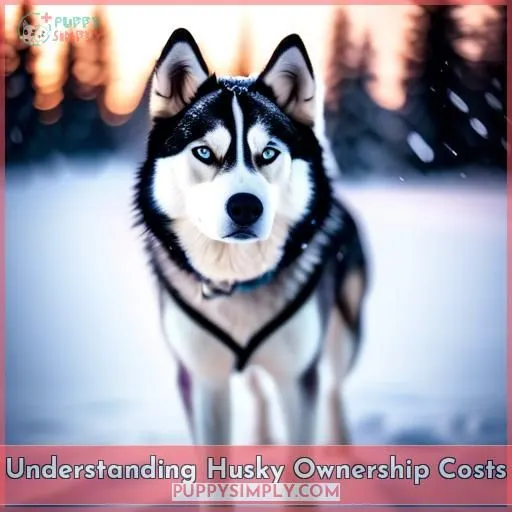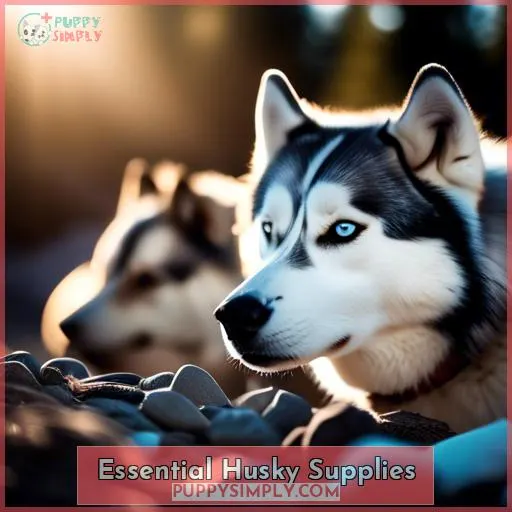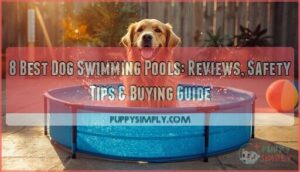This site is supported by our readers. We may earn a commission, at no cost to you, if you purchase through links.
When pondering the typical cost of obtaining a Husky, you’re gazing upon an initial acquisition outlay ranging from $150 to $1,500, contingent upon whether you embrace or procure from a cultivator. Pure lineages tend to be more costly, but crossbreeds may alleviate future health expenditures.
Imperative provisions such as bedding, enclosures, and grooming accoutrements can amplify your incipient expenses by $110 to $310. Unceasing solicitude, encompassing sustenance, veterinary consultations, and instruction, could set you back $540 to $2,750 annually. Unanticipated expenses, such as emergent medical outlays, could surface.
By electing for self-performed grooming, wholesale acquisitions, and economical pet insurance, you can administer these expenses more efficaciously. For a thorough delineation of the average cost of purchasing a Husky with 21 exemplars, further inquisition will disclose invaluable discernments.
Table Of Contents
- Key Takeaways
- Understanding Husky Ownership Costs
- Initial Purchase Price of a Husky
- Essential Husky Supplies
- Ongoing Care Expenses
- Unexpected Husky Costs
- Saving on Husky Costs
- Frequently Asked Questions (FAQs)
- What is the average cost of owning a Husky for the first year?
- How much does it cost to adopt a Husky from a rescue or shelter?
- What are the common costs for veterinary care, grooming, and training for a Husky?
- How can I save money on Husky care, such as by doing all the walking myself or buying food in bulk?
- What are the long-term costs of owning a Husky, including annual expenses like food, grooming, and veterinary care?
- Conclusion
Key Takeaways
- The initial acquisition cost of a Husky ranges from $150 to $1,500, with purebreds generally being more expensive than mixes.
- Essential supplies such as bedding, crates, and grooming tools can add an additional $110 to $310 to the initial costs.
- Ongoing care expenses, including food, veterinary visits, and training, can amount to $540 to $2,750 annually.
- Unexpected costs, such as emergency medical expenses, can arise, but can be managed more effectively through self-performed grooming, bulk purchases, and choosing affordable pet insurance.
Understanding Husky Ownership Costs
Welcome to the husky-owning adventure! As you start on this thrilling path, it’s vital to know that huskies have unique health concerns, exercise needs, climate considerations, and personality traits that can have a big impact on your finances. In this article, we’ll explore the various expenses of owning a husky, starting with the basics of their care.
First and foremost, huskies need at least 30 to 60 minutes of moderate to intense exercise every day to burn off their extra energy and stop them from acting out. This exercise plan should be made for your husky’s age, health, and energy level, and it’s important to talk to a vet about what exercises are best. Regular vet visits will make sure you’re giving your husky the right amount of exercise for their overall health.
Socialization is also very important for huskies. They’re pack animals and need a lot of time with people and other dogs. Socialization strategies include regular walks around the neighborhood, trips to the park, and organizing playdates with dogs that match your husky’s personality. Remember, socialization is a lifelong process for your husky, as they may start to be wary of new things as they get older.
Now that we’ve covered the exercise and socialization needs, let’s talk about some of the other essential supplies you’ll need for your husky. These include a comfortable bed and crate, leashes and collars, and grooming tools. While these items may not be as expensive as some other parts of owning a husky, they’re still necessary for your husky’s well-being.
In the next section, we’ll look into the initial cost of buying a husky, discussing the differences between breeder and adoption fees, purebreds and mixes, and how these factors can affect your overall husky ownership expenses.
Initial Purchase Price of a Husky
When considering the initial purchase price of a Husky, there are two main options: buying from a breeder or adopting from a rescue organization. The cost of a purebred Husky from a reputable breeder can range from $600 to $1,500, with prices potentially reaching as high as $6,000 for rare colors or dogs with champion bloodlines. Adoption fees, on the other hand, are generally lower, ranging between $150-$400 depending on the organization and region.
In terms of breed, purebred Huskies are typically more expensive than mixed breeds or mutts, which may be more affordable for those on a budget. The cost of a Husky can also be influenced by factors such as location, breeder reputation, lineage, and the specific color of the dog. It’s crucial to avoid purchasing puppies from pet stores or online sellers associated with puppy mills, as these dogs often have health issues due to improper breeding practices.
When adopting a Husky, it’s vital to be aware that some adoption fees may include basic vet care and vaccinations, while others may not. Additionally, some breeders may include veterinary procedures like vaccinations, microchipping, and spaying/neutering in the initial purchase price.
Breeder Vs. Adoption Fees
Regarding Husky adoption, there are two primary avenues: breeder or adoption. Each presents its own advantages and disadvantages, so let’s delve into the specifics:
- Breeder: Breeders often provide health warranties and may offer temperament testing, which can be advantageous for those seeking a specific breed standard or genetic soundness. However, breeders may impose higher costs, with typical waiting list deposits ranging from $200 to over $1,000.
- Adoption: Acquiring a Husky from a rescue or shelter generally incurs lower expenses than purchasing from a breeder. Adoption fees for Husky rescues vary from $275 to $400, influenced by the dog’s age. Additionally, adoption enables you to make a significant impact by providing a loving home to a dog in need.
In terms of genetic health, both options present challenges. Breeders may possess greater influence over genetic health, but they also risk inadvertently elevating the likelihood of inbreeding and the manifestation of recessive genes. Conversely, adoption may involve dogs with uncertain genetic histories, but it also offers the opportunity to rescue a dog from a shelter or rescue, which can be profoundly fulfilling.
Ultimately, the decision between breeder and adoption hinges on your personal preferences, financial situation, and the unique requirements of the dog you intend to adopt. It’s crucial to thoroughly research and select a reputable breeder or adoption organization to optimize the outcome for both yourself and your new canine companion.
Purebred Vs. Mixes
After examining breeder versus adoption fees, you’ll also want to evaluate the husky size, health concerns, and life expectancy when selecting between a purebred and a mix. Purebreds, frequently kennel club registered and homozygous, can be susceptible to harmful genes leading to conditions like progressive retinal atrophy.
Mixes may have diverse temperaments and exercise requirements but can also provide a genetic health advantage.
Essential Husky Supplies
To examine the subtopic of ‘Essential Husky Supplies’, we’ll focus on the following points: Bedding and Crates, Leashes and Collars, and Grooming Tools.
Bedding and Crates:
When it comes to bedding and crates for your Husky, you’ll need to invest in a comfortable and durable bed that can endure their strength and chewing habits. A good quality dog bed can cost between $30 to $60 per month. Additionally, if you plan to crate train your Husky, you’ll need a sturdy crate that can accommodate their size. Crates can range from $50 to $200, depending on the size and material.
Leashes and Collars:
A properly fitted collar and leash are essential for controlling your Husky during walks and training sessions. Leashes can cost between $10 to $50, while collars can range from $15 to $50. It’s recommended to invest in a durable, adjustable collar to guarantee a proper fit as your Husky grows.
Grooming Tools:
Huskies have a thick, double coat that requires regular grooming to manage shedding and maintain coat health. Professional grooming can cost between $40 to $75 per month, while self-grooming will require investment in the right tools such as brushes, nail clippers, and ear cleaners. These tools can cost between $20 to $50.
In summary, essential Husky supplies can add up to an average of $140 to $285 per month, depending on the quality and durability of the items you choose. It’s crucial to take these costs into account when budgeting for your new Husky companion.
Bedding and Crates
Bedding and Crates for Your Husky: Essential Supplies
Bedding and crates are vital for your Husky’s comfort and safety. Here’s what you need to know:
- Bed size: Opt for a bed that’s spacious enough for your Husky to rest comfortably with its limbs fully extended.
- Bed location: Position the bed in a warm, tranquil area away from drafts and direct sunlight.
- Bed materials: Consider orthopedic foam beds for support and cooling gel beds for temperature regulation.
- Bed cost: Prices range from $50 to $100 for a basic bed, with more expensive options available for specialized needs.
- Crate size: Choose a crate that’s large enough for your Husky to stand, sit, and lie down comfortably.
- Crate materials: Seek out durable, easy-to-clean materials like plastic or metal.
- Crate cost: Prices range from $70 to $160, depending on the size and materials.
Crate Training
Crate training is a key part of housebreaking and safety training for your Husky. It provides a secure space for your dog and helps prevent destructive behavior.
- Crate training tips: Introduce the crate gradually, using positive reinforcement, and avoid using the crate as a punishment.
- Crate training benefits: Crate training helps your Husky learn to control its bladder and bowel movements, reduces anxiety, and provides a safe space during travel.
Bedding and Crate Examples
- Beds: The Sealy Lux offers cooling and orthopedic properties, while the Bedsure Waterproof Orthopedic Bed is ideal for crates and kennels.
- Crates: The Bedsure Waterproof Orthopedic Bed is a budget-friendly option for crates and kennels.
Bedding and Crate Costs
- Bedding: Expect to spend $50 to $100 on a basic bed.
- Crates: Prices range from $70 to $160, depending on the size and materials.
Additional Considerations
- Bedding and crate placement: Place the bed and crate in a quiet, comfortable area away from drafts and direct sunlight.
- Bedding and crate maintenance: Regularly clean and maintain your Husky’s bed and crate to guarantee their comfort and safety.
Bedding and Crate Costs in 21 Examples
- Bedding: $50 to $100
- Crates: $70 to $160
Essential Husky Supplies
- Bedding: Husky bedding, $50 to $100
- Crates: Husky crates, $70 to $160
- Leashes and Collars: Husky leashes and collars, $20 to $50
- Grooming Tools: Husky grooming tools, $30 to $60
- Food and Treats: Husky food and treats, $40 to $80 per month
- Veterinary Care: Husky veterinary care, $200 to $500 per year
- Training and Socialization: Husky training and socialization, $125 to $1,000
- Unexpected Expenses: Emergency medical expenses, $200 to $500
- Replacement of Damaged Items: Replacement of damaged items, $50 to $100
Saving on Husky Costs
- DIY Grooming: DIY Husky grooming, $0 to $50
- Buying Supplies in Bulk: Buying Husky supplies in bulk, $10 to $50
- Choosing Affordable Pet Insurance: Affordable Husky pet insurance, $50 to $100 per month
Essential Husky Supplies: Bedding and Crates
- Bedding: Husky bedding, $50 to $100
- Crates: Husky crates, $70 to $160
Essential Husky Supplies: Leashes and Collars
- Leashes and Collars: Husky leashes and collars, $20 to $50
Essential Husky Supplies: Grooming Tools
- Grooming Tools: Husky grooming tools, $30 to $60
Essential Husky Supplies: Food and Treats
- Food and Treats: Husky food and treats, $40 to $80 per month
Essential Husky Supplies: Veterinary Care
- Veterinary Care: Husky veterinary care, $200 to $500 per year
Essential Husky Supplies: Training and Socialization
- Training and Socialization: Husky training and socialization, $125 to $1,000
Essential Husky Supplies: Unexpected Expenses
- Unexpected Expenses: Emergency medical expenses, $200 to $500
Essential Husky Supplies: Replacement of Damaged Items
- Replacement of Damaged Items: Replacement of damaged items, $50 to $100
Essential Husky Supplies: DIY Grooming
- DIY Grooming: DIY Husky grooming, $0 to $50
Essential Husky Supplies: Buying Supplies in Bulk
- Buying Supplies in Bulk: Buying Husky supplies in bulk, $10 to $50
Essential Husky Supplies: Choosing Affordable Pet Insurance
- Choosing Affordable Pet Insurance: Affordable Husky pet insurance, $50 to $100 per month
Essential Husky Supplies: Total Cost
- Total Cost: $1,740 to $5,210 per year
Essential Husky Supplies: Breakdown
- Bedding and Crates: $120 to $320
- Leashes and Collars: $40 to $100
- Grooming Tools: $60 to $150
Leashes and Collars
Choosing the right leashes and collars for your husky isn’t just about keeping them close; it’s about embracing their spirit of adventure while ensuring their safety. Think of it as their ticket to explore, with you guiding the way. Here’s a quick guide to help you pick:
| Type | Average Cost |
|---|---|
| Husky Harnesses | $25 – $50 |
| Retractable Leashes | $20 – $40 |
| Anti-Pull Harnesses | $30 – $60 |
| Collar Tags | $5 – $15 |
| Training Collars | $15 – $35 |
Grooming Tools
As a responsible Husky owner, you’ll need essential grooming tools to keep your furry friend looking and feeling their best. These tools include grooming accessories designed for coat maintenance, brush types for shedding, and nail trimming equipment.
- Grooming Accessories: Invest in a high-quality, self-cleaning brush like the King Komb, which is specifically designed for Husky shedding. This tool is ergonomically designed and features soft rubberized bristles that are gentle on your Husky’s skin while effectively removing excess hair and allergenic dander.
- Brush Types: Choose from a variety of brushes to suit your Husky’s coat type and shedding patterns. Slicker brushes, de-matting tools, and pin brushes are all useful for Husky grooming.
- Nail Trimming: Keep your Husky’s nails trimmed to prevent overgrowth and discomfort. Look for nail clippers specifically designed for dogs, and consider using a Dremel tool for a more precise trim.
- Bath Frequency: Determine how often your Husky needs a bath based on their activity level and environment. Generally, a monthly bath is sufficient, but this may vary depending on your Husky’s individual needs.
- Sk 6mm-24mm Set: A set of brushes with varying sizes can help you tackle different areas of your Husky’s coat more effectively.
- 18mm Line Wrench, 16mm Bolt, 18mm Oil Drain Plug, 18mm Caliper Bracket: These tools may be useful for Husky grooming, especially if you plan to do any maintenance on your Husky’s grooming equipment.
Ongoing Care Expenses
Owning a Husky can be a fulfilling experience, but it entails various expenses beyond the initial purchase price, such as medical care, grooming costs, and training. In this article, we’ll discuss the ongoing care expenses for Huskies, including food and treats, veterinary care, and training and socialization.
Food and Treats:
Huskies are energetic dogs that require high-quality food to maintain their health and well-being. The cost of dog food for Huskies can range from $340 to $600 annually, depending on the quality of the food chosen. Treats are also essential for training and rewarding good behavior, and they can cost between $400 and $800 per year.
Veterinary Care:
Huskies are susceptible to certain health conditions, such as hip dysplasia and eye problems, which may require additional veterinary care. The cost of veterinary care for Huskies can range from $150 to $2,000 annually, depending on the specific needs of the dog. Regular check-ups and preventative measures like flea/tick prevention medication or heartworm medicine can cost between $100 and $300 per month.
Training and Socialization:
Huskies are intelligent dogs but can be challenging to train. The cost of training classes or hiring a professional dog trainer can range from $50 to $150 per session. Socialization is also indispensable for Huskies to ensure they develop good behavior and can interact well with other dogs and people. This can involve attending dog parks, training classes, or hiring a dog walker or sitter.
Unexpected Costs:
In addition to these ongoing expenses, there may be unforeseen costs, such as emergency medical expenses or the replacement of damaged items. These costs can vary widely depending on the individual dog’s needs and circumstances.
Saving on Husky Costs:
There are several ways to save on Husky costs, such as adopting from a shelter or rescue organization, purchasing an older dog instead of a puppy, and buying high-quality dog food in bulk or during sales events. Choosing affordable pet insurance can also help manage veterinary expenses.
In conclusion, owning a Husky is a significant financial commitment, with ongoing care expenses including food and treats, veterinary care, and training and socialization. By considering these costs and implementing cost-saving strategies, potential owners can ensure they provide the best care for their furry friend while managing their budget.
Food and Treats
As a responsible husky owner, you understand the significance of providing your furry friend with a well-balanced diet that satisfies their unique nutritional requirements. Given the diverse options available, from commercial raw dog food to homemade treats, it’s crucial to weigh the advantages and disadvantages of each choice to make sure your husky remains healthy and joyful.
- Commercial Raw Dog Food: Brands like Stella & Chewy’s, Primal, and Nature’s Variety Instinct provide raw dog food options that can be convenient for busy pet owners. However, these options can be more costly compared to traditional dry dog food, with monthly expenses ranging from $202 to $225.
- Homemade Treats: Creating your own treats using ingredients like chicken thighs, chicken liver, and vegetables can be a budget-friendly alternative. Nevertheless, it necessitates time and effort to verify that your husky is receiving a well-balanced diet. Additionally, you may need to consider supplements like calcium tabs, glucosamine, and fish oil to guarantee that your husky’s nutritional needs are met.
- Raw Feeding: Feeding your husky a raw diet can provide the benefits of knowing precisely what’s in their food and potentially eliminating certain food sensitivities. However, it can be more expensive and requires meticulous planning to make sure your husky is getting all the necessary nutrients, including vitamins and minerals.
- Standard Dry Dog Food: Brands like Iams, Hills Science Diet, and Purina One provide standard dry dog food options that can be more affordable compared to other options. However, these options may not offer the same level of nutritional advantages as raw or commercial raw dog food.
- Pet Insurance for Dogs and Cats: While not directly related to your husky’s diet, pet insurance can help cover unexpected veterinary expenses, providing peace of mind for pet owners. Average pet insurance costs for dogs are $66 per month, while for cats it’s $32 per month.
Veterinary Care
Veterinary care is a vital aspect of pet ownership, and it can be quite expensive. As a responsible pet owner, you want to make sure that your furry friend stays healthy and receives the necessary medical attention when needed. However, the cost of veterinary care can add up quickly, especially when unexpected health issues arise. In this section, we’ll discuss the various aspects of veterinary care and how to manage these costs effectively.
Vaccinations: Regular vaccinations are essential for the health of your pet. They protect against common diseases such as rabies, distemper, and parvovirus. The cost of vaccinations varies depending on the type and frequency of the shots.
Spaying/Neutering: Spaying or neutering your pet is an important step in preventing unwanted pregnancies and reducing the risk of certain health issues. The cost of spaying/neutering can vary depending on the age and size of your pet, as well as the location and the veterinarian’s fees.
Microchipping: Microchipping is a permanent form of identification for your pet. It involves implanting a small chip under the skin, which can be scanned to identify the pet’s owner. The cost of microchipping is relatively low and usually ranges from $20 to $50.
Dental Care: Regular dental check-ups and cleanings are essential for maintaining your pet’s oral health. The cost of dental care can vary depending on the severity of the issue and the type of treatment required.
Parasite Prevention: Preventing parasites such as fleas, ticks, and heartworms is critical for your pet’s health. The cost of parasite prevention can vary depending on the type of treatment and the frequency of administration.
Pet Insurance Coverage: Pet insurance can help you manage the costs of veterinary care. It typically covers accidents, injuries, and certain illnesses. The cost of pet insurance can vary depending on the type of coverage, deductibles, and premiums.
To manage the costs of veterinary care, consider the following tips:
Budgeting: Set aside a monthly budget for veterinary care. This will help you plan for unexpected expenses and guarantee that you can afford necessary treatments.
Shop Around: Compare prices and services among different veterinarians and clinics. You may find that some offer more affordable rates or better deals.
Preventive Care: Regular check-ups and preventive care can help you catch health issues early, which can save you money in the long run.
Pet Insurance: Consider investing in pet insurance to help cover the costs of veterinary care. Be sure to compare policies and choose one that suits your pet’s needs and your budget.
Training and Socialization
Training and socialization are fundamental aspects of owning a husky. Obedience training is essential for managing your husky’s energy and ensuring a peaceful living environment. Leash training is necessary for outdoor activities.
Socialization strategies, such as puppy classes, assist your husky in learning to interact with other dogs and people. Behavior modification might be required for specific concerns.
The cost of training and socialization varies, but it’s an ongoing expense to factor in when owning a husky.
Unexpected Husky Costs
Unexpected Husky Costs: Be Prepared for Emergency Medical Expenses and Replacement of Damaged Items.
Emergency Medical Expenses
Emergency medical expenses can be a significant concern when owning a Husky. Unforeseen medical emergencies, such as surgical procedures, can result in hefty out-of-pocket expenses. Insurance coverage can help mitigate these costs, but it’s important to understand the limits and exclusions of your policy.
Preventative care, such as regular vet visits and vaccinations, can also help reduce the likelihood of unexpected medical emergencies. When considering the average cost of buying a Husky, it’s vital to factor in potential emergency medical expenses to make sure you’re prepared for any unexpected costs.
Replacement of Damaged Items
As a Husky owner, you’ll inevitably grapple with the burden of mending broken belongings. From mangled toys to gnawed furniture, these expenses can mount rapidly. Pet insurance can alleviate these costs, but it often comes with deductibles and graded coverage options.
When assessing pet insurance options, ponder the extent of replacement costs coverage offered. Some policies might encompass the replacement of damaged items, while others might not. It’s crucial to balance the price of insurance against the prospective savings in replacement costs.
In the context of the average cost of acquiring a Husky, these unforeseen expenses are just one of the myriad factors to ponder. By grasping the potential costs associated with owning a Husky, you can better prepare for the path ahead.
Saving on Husky Costs
To save on Husky costs, consider DIY grooming, buying supplies in bulk, and choosing affordable pet insurance. These strategies can help reduce expenses related to food, grooming, and veterinary care.
DIY Grooming
Welcome, fellow Husky owner! In this section, we’ll delve into the realm of DIY grooming for your cherished Siberian Husky. We’ll probe the technique of bathing, nail trimming, tooth cleaning, and ear cleaning, all while preserving your financial well-being.
Bathing:
Bathing your Husky is an integral part of their grooming regimen. However, it’s not a weekly requirement. Most Huskies don’t necessitate frequent baths, as their fur is naturally oily and self-cleansing. Bathe only when indispensable, such as after a roll in something unsavory or when they’re shedding profusely. Use a mild shampoo and rinse thoroughly. Remember, excessive bathing can deplete the fur of its natural oils, rendering it more susceptible to dirt and grime.
Nail Trimming:
Elongated nails can induce discomfort, hinder your dog’s ambulatory abilities, and even lead to grave health issues. Trim your Husky’s nails routinely, using scissor-style clippers for enhanced control over thicker nails. Be wary not to cut the quick, the sensitive, blood-rich region within the nail. If you inadvertently cut the quick, utilize styptic powder to stanch the bleeding.
Teeth Cleaning:
Dental hygiene is paramount for your Husky’s overall well-being. Brush their teeth regularly with a canine-specific toothpaste and a soft-bristled toothbrush. You can also utilize dental chews and treats to assist in maintaining their oral health.
Ear Cleaning:
Ear cleaning is requisite to prevent ear infections. Use a gentle ear cleaner specifically formulated for dogs. Be certain to clean only the external ear canal, as venturing too deep can cause damage. If you observe redness, discharge, or a foul odor, consult your veterinarian.
In the ensuing section, we’ll explore the advantages of purchasing supplies in bulk to minimize Husky grooming expenses. Stay attuned!
Buying Supplies in Bulk
Purchasing supplies in abundance can substantially decrease your expenses associated with your Husky. Explore quantity discounts on necessities such as sustenance, rewards, and grooming instruments. Subscription boxes present convenience and financial savings.
Joint purchasing with companions or neighbors can also be advantageous. Warehouse clubs and virtual merchants frequently offer ample choices for wrench sets and other equipment. Simply ensure proper storage of your mass purchases to preserve their quality.
Choosing Affordable Pet Insurance
When selecting economical pet insurance for your Husky, there are numerous possibilities to examine. Commence by collating providers and their supplementary coverage. Seek discounts and promotions to reduce your expenditures.
Evaluations of customer service can also aid you in assessing the caliber of support you’ll acquire.
Bear in mind that the mean cost of acquiring a Husky with 21 illustrations encompasses the continuing expenditure of pet insurance. Thus, ensure that you incorporate this into your budget.
Frequently Asked Questions (FAQs)
What is the average cost of owning a Husky for the first year?
The average cost of owning a Husky for the first year is around $2,400 to $5,585, which includes expenses such as buying or adopting a Husky puppy, vet care, supplies, grooming, training, food, and insurance.
How much does it cost to adopt a Husky from a rescue or shelter?
Adopting a Husky from a rescue or shelter can range from $275 to $400, depending on the dog’s age. This is generally less expensive than buying from a breeder. The adoption fees typically cover the costs of veterinary care, vaccinations, spaying or neutering, and other necessary treatments.
What are the common costs for veterinary care, grooming, and training for a Husky?
Caring for a Husky? Vet visits may run you $430-$630 yearly, grooming could cost a pretty penny at $900 annually, and training might set you back $150-$200 for group classes.
How can I save money on Husky care, such as by doing all the walking myself or buying food in bulk?
To save money on Husky care, consider doing all the walking yourself. This can help reduce expenses without compromising your Husky’s well-being.
Buying food in bulk is another strategy to save money. This can be more cost-effective than purchasing smaller quantities.
Performing regular grooming at home is also a way to save on Husky care costs. This can be done instead of taking the dog to a professional groomer.
Adopting from a shelter or purchasing an older dog instead of a puppy can save money on veterinary care and training. Puppies often require more intensive care and training, which can be more expensive.
By focusing on preventive measures and investing in quality accessories that last longer, you can effectively manage the costs associated with owning a Husky.
What are the long-term costs of owning a Husky, including annual expenses like food, grooming, and veterinary care?
Owning a Husky can cost $1,500-$3,000 upfront and $1,000-$2,000 annually for food, grooming, veterinary care, and other expenses. Factors like health issues and activity level can markedly impact the total lifetime cost of a Husky.
Conclusion
Considering the expenses associated with owning a Husky? Explore this article for an extensive analysis of the average cost of purchasing one, including 21 examples. From initial procurement to continuous maintenance and unforeseen expenses, we provide comprehensive information. By comprehending these costs and adopting cost-effective strategies, you can become a responsible and knowledgeable Husky owner.













